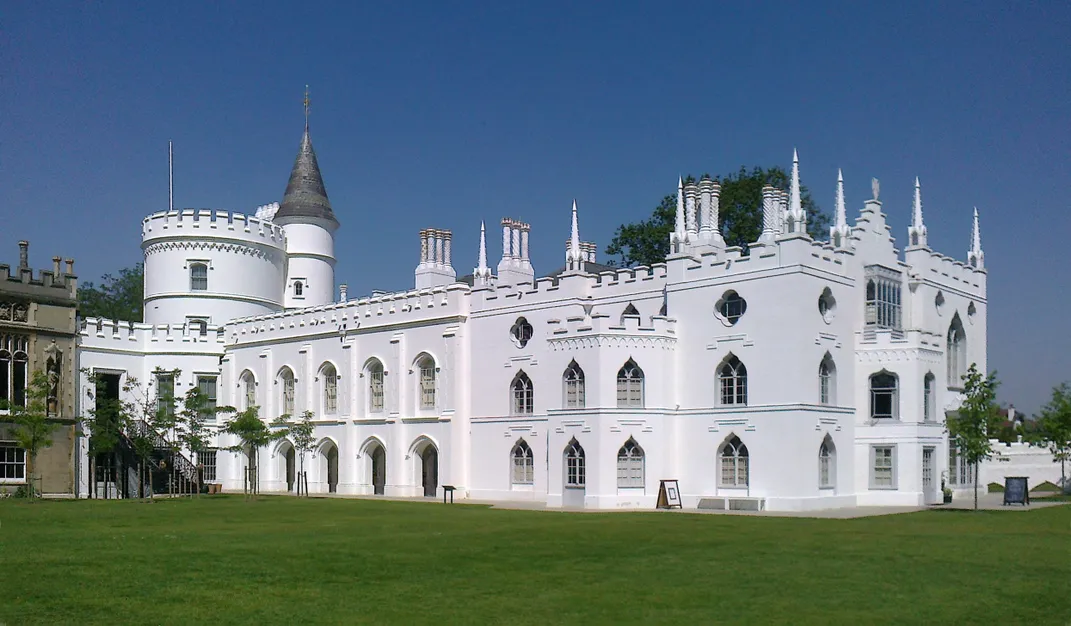Rarely Seen Portrait of Renaissance Queen Catherine de’ Medici to Go on View
The 16th-century regent, pictured with four of her children, wielded significant political power during the French Wars of Religion
:focal(385x141:386x142)/https://tf-cmsv2-smithsonianmag-media.s3.amazonaws.com/filer/46/4b/464b6ca7-c8b2-454b-909e-bc369a83bd15/steq.png)
Though Catherine de’ Medici stands in the background of this monumental 1561 portrait, her pose reveals her true power. Then acting as regent of France, the Italian noblewoman wears black—a symbol of mourning for her late husband Henry II—and wraps her arms around her newly crowned son, Charles IX. Catherine’s firm grip on the young Charles communicates her influence: In the years following her husband’s death, she effectively ruled France in her son’s stead, becoming one of the most influential female politicians of 16th-century Europe.
Horace Walpole, an 18th-century British politician, acquired the portrait as part of his expansive collection of curios. The only surviving contemporary painting of Catherine, the work all but disappeared from public view in the mid-1800s, when Walpole’s heirs sold it at auction, writes Maev Kennedy for the Art Newspaper.
Last week, officials revealed that the sumptuous image has been returned to Walpole’s former home and museum at Strawberry Hill House, a medieval-style castle in west London. Now, after nearly two centuries in private hands, this historic painting is set to go on public display. Per a statement, visitors will be able to examine the work up close when Strawberry Hill reopens on May 17.
The portrait’s anonymous owners returned the work to its former home in lieu of paying £1 million in taxes. As Claire Selvin reports for ARTNews, this program allows families to pay off some or all of their inheritance taxes by transferring heritage objects into the public domain.

As the museum notes in the statement, Walpole was a history fanatic obsessed with the Tudors, the Medicis, the House of Valois and other prominent European families. Experts don’t know exactly how this French portrait arrived in England, but records reflect that Walpole purchased it in 1742 “from a Mr. Byde Herfordshire.” The monumental work cost Walpole £25—a “sizable sum” for the time period, as Dalya Alberge observes for the Guardian. (Adjusted for inflation, this sale price equates to almost $6,000 today.)
Walpole had once considered writing a history of the Medici family—even preparing initial research for the project in 1759—but eventually dropped the project due to a lack of archival material. According to the Art Newspaper, he decorated his eccentric mansion with fireplaces, bookcases, Gothic carved ceilings and other fantastical elements inspired by the Middle Ages and the Renaissance. (An avid collector, Walpole even dedicated an entire room of the house to his trove of Tudor artifacts, per the statement.)
In 1842, Walpole’s estate was dismantled and scattered in a major auction, per the Art Newspaper. The house was restored as a museum in 2010.
As for the painting itself, experts think that it is one of the few—if not the only—depictions of Catherine created during her lifetime. Researchers attribute the likeness to the workshop of François Clouet, a prominent French court painter.
An inscription on the painting indicates that Charles is “in his eleventh year,” a timeline that places the work about a year after the young king’s coronation in 1560, per the statement. The young Charles stands next to three of his ten siblings: future king Henry III, then Duke of Anjou; Marguerite de Valois, the future queen of Navarre; and François-Hercule, Duke of Anjou and Alençon.
Born into the famed Italian banking family in 1519, Catherine wielded limited political influence as queen consort. But after her husband’s untimely death in 1559, her power grew substantially. She advised her eldest son, Francis II, and his wife, Mary, Queen of Scots, during their brief reign (Francis died at age 16 after ruling for just over a year), then served as regent for Charles. When Charles died in 1574 at age 23, Catherine continued to govern on behalf of her third son, Henry.
In the decades following the 1561 portrait’s creation, Catherine oversaw the French royalty’s response to the Wars of Religion, a series of bloody battles between French Protestants (Huguenots) and Roman Catholics. When Charles was still a young ruler, Catherine played an instrumental role in plotting and authorizing the killing of more than 3,000 Protestant leaders in the St. Bartholomew’s Day Massacre of 1572.
“The acquisition of this unique portrait of Catherine de’ Medici with her children is important not just for its great intrinsic value and meaning, but also because it gives us, at Strawberry Hill House, the possibility to reconstruct one of the many historical narratives that were at the basis of Walpole’s collecting strategies,” says curator Silvia Davoli in the statement. “This portrait speaks to us of Walpole’s interest in the Italian and French Renaissance, its protagonists and great art.”
/https://tf-cmsv2-smithsonianmag-media.s3.amazonaws.com/accounts/headshot/nora.png)
/https://tf-cmsv2-smithsonianmag-media.s3.amazonaws.com/filer/a0/d4/a0d41e1f-46f8-4ad3-89c2-33961a70c62d/hanging_the_work.jpeg)
/https://tf-cmsv2-smithsonianmag-media.s3.amazonaws.com/filer/26/6d/266d976e-c056-4eed-aa4b-11b491418704/shh-painting-mattchungphoto-lo-res-9.jpeg)
/https://tf-cmsv2-smithsonianmag-media.s3.amazonaws.com/accounts/headshot/nora.png)